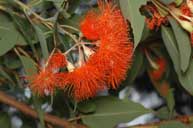In Flower This Week
A weekly news sheet prepared by a Gardens' volunteer.
Numbers before each plant refer to temporary IFTW labels in the gardens.
Numbers in square brackets [ ] refer to garden bed Sections. Plants in flower are in bold type.
View past issues of 'In Flower This Week'.
22 January 2014
Corymbia ficifolia 'Dwarf Orange' click for larger image |
We will start our walk from the Visitor Information Centre (VIC) then head up the hill past the rear of the café to the Rock Garden.
- After you leave the VIC on the right there is a group of Banksia serrata [Section 174], also called Old Man Banksia or Saw Banksia, behind the sculpture of Sir Joseph Banks. They have large greenish cones and ovate leaves with toothed margins. Banksia serrata is a widespread species in eastern Australia, extending from southern Queensland to Victoria's south coast. There is also a population across Bass Strait in northern Tasmania. The plant occurs as far inland as the Great Dividing Range.
- Now look up to your left to see Corymbia ficifolia ‘Dwarf Orange’ [Section 210], a small tree with brilliant orange fluffy blooms and dark green foliage. This grafted gum, originally from Western Australia, is one of the most spectacular when in full flower.
- Turn up the hill to your left, then turn right towards the Rock Garden. On the right is Persoonia pinifolia[Section 110] or Pine–leaved Geebung, a large weeping shrub with needle-like foliage and racemes of yellow pointed flowers.
- Turn left up the steps into the Rock Garden to see three different Hibbertias. First on your left is Hibbertia serpyllifolia [Section 15c] or Hairy Guinea Flower, showing very fine light green foliage with 5-petalled lemon flowers in profusion.
- Hibbertia pedunculata [Section 15d] on your right has brighter yellow flowers and fine creeping foliage. The species name ‘pedunculata’ refers to the flower having a peduncle or long stalk.
- Lastly on your left is Hibbertia vestita [Section 15c], which is also known as the Hairy Guinea Flower (this is why common names can be confusing!). It has gold flowers on a creeping bush. ‘Guinea Flower’ refers to the shape and colour of the flower being like a golden guinea coin.
- Turn right and on your upper left is Grevillea albiflora [Section 15g] or White Spider Flower, a large sweet-smelling bush with long needle-like foliage and white brushes with prominent styles.
- On your right is Beaufortia decussata [Section 15f], a small shrub with red fluffy flowers with green centres and neat, close foliage. The species name ‘decussata’ refers to the leaf arrangement where each pair of leaves is arranged at right angles to the previous pair on the stems.
- Turn right and on your left Acacia aneura var. aneura [Section 15l], commonly known as Mulga, is in full bloom with gold fluffy balls on needle-like greyish-green foliage. Mulga is believed to live as long as 400 years.
- Turn left and on your left is Muehlenbeckia axillaris [Section 15l] forming a mat of tiny rounded leaves with masses of small yellow flowers.
- Turn right down the steps and on the left is Eremophila alternifolia [Section 15r] with pink tubular flowers on an open bush with upright foliage. Eastern Spinebills love these tubular flowers which fit their beaks.
- Eremophila bignoniiflora x polyclada [Section 15r] also on the left shows masses of large white tubular flowers with purple- spotted throats.
- On the far left is Melaleuca nesophila [Section 15r], an upright shrub with purplish-pink flowers fading to white, giving it a two-tone appearance.
- Lythrum salicaria [Section 15s] or Purple Loosestrife has tall sprays of purple-pink flowers with red stems.
- Teucrium racemosum [Section 15v] is a delicate small bush with narrow silvery leaves and white flowers with a prominent lip.
Rosalind Walcott
![Director of National Parks [logo]](../../../../images/dnp_90px.gif)







